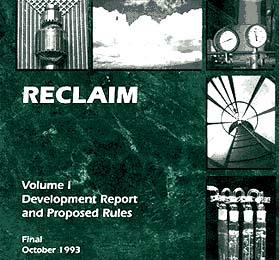Regulations: NOx Control
Environmental Issues
International Competition
Major Products and Markets
Regulations and NOx Control
Summary
Trends / Major Products
Trends / Employment and Productivity
Trends / Energy Consumption by Fuel
Trends / Primary Aluminum Production
Trends / Total Supply of Aluminum
Trends / World Aluminum Output
Trends / Distribution of Power Plants
Trends / Distribution of Processing Plants
There are a number of regulatory bodies which have implemented or are proposing air quality legislation which will impact aluminum processing plants. The most active regulation body in this area in the U.S. is the South Coast Air Quality Management District (SCAQMD) in Southern California. In addition to SCAQMD, the Clean Air Act Amendments of 1990 requires that each state develop an implementation plan for controlling NOx as well as other criteria and hazardous pollutants from residential, commercial, and industrial sources. A summary of the proposed and implemented regulations impacting aluminum processing plants are as follows:
SCAQMD
The SCAQMD does not have any specific rules governing NOx emissions from aluminum processing plants per se. The equipment used in aluminum processing plants is classified as either metal melting furnaces or process heaters and are governed by Regulation IX (New Source Performance Standards) or 1146 (1446 – Emissions of NOx from Process Heaters – SCAQMD Rule 1146 applies to process heaters greater than 5 MMBTU/hr. The regulation specifies, based on process heater size, the allowable emission rate of NOx). Large aluminum processing plants which emitted over 4 tons of NOx per year prior to 1994 are controlled by the REgional CLean Air Incentives Market (RECLAIM). RECLAIM is a market based pollution control strategy which was implemented by the South Coast Air Quality Management District (SCAQMD) in 1993. Under RECLAIM, the federal clean air standards for NOx are met on a facility by facility basis, rather than through traditional command-and-control legislation of specific emitters. Each facility falling under RECLAIM is provided an annual emissions cap. Facilities with emissions above their annual emissions cap have the option to adopt control technologies to process equipment, or purchase RECLAIM Trading Credits (RTCs) from other RECLAIM facilities emitting below their cap. The SCAQMD anticipates that this pollutant reduction scheme will significantly decrease the cost of compliance in the Southern California basin.
EPA
Under the Clean Air Act Amendments of 1990, aluminum processing companies considered to be major sources are required to submit a Title V application by the due date established by the state regulatory agency, and some states require that minor sources (minor sources are simply facilities which do not meet the definition of a major source) also obtain permits. Each state was required to submit its Title V program to the EPA by November 15, 1993, with approval expected within a year. Many states, however, did not submit complete programs by the due date, and the EPA did not complete its review of the state plans within the projected year, so many of these state implementation plans are still undecided.
Major, and sometimes minor, sources operating in non-attainment areas or emitting hazardous air pollutants are required to submit a compliance plan permit application for mitigating emissions. The permitting process also requires that the company meet more stringent monitoring and record keeping requirements. The EPA will issue permits with a five (5) year life based on the company’s permit application.
The classification of a facility as a major source is dependent upon the attainment status of the facility region. A summary of the threshold levels for major sources can be seen below:
Severity of Nonattainment by Size of Major Source
| Marginal | Moderate | Serious | Severe | Extreme |
| 100 TPY | 100 TPY | 50 TPY | 25 TPY | 10 TPY |
OTC
The Ozone Transport Commission was formed to coordinate the ozone reduction implementation plans for 10 Northeast states. This coordination is necessary since upwind states which are classified as attainment regions by the EPA contribute to the ozone problem of downwind states. In this region, it is possible that aluminum processing plants which are located in attainment regions will be treated as sources in serious, severe, or extreme nonattainment regions.

